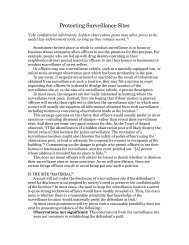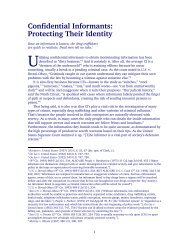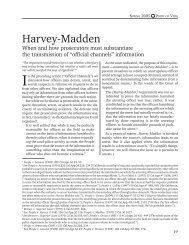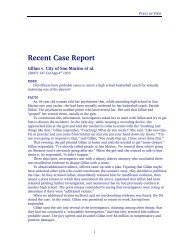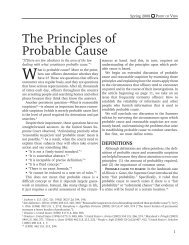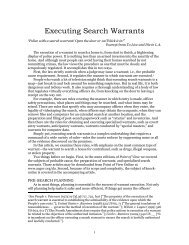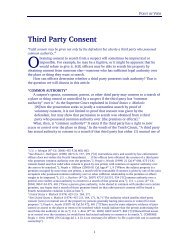PC TO ARREST.pmd - Alameda County District Attorney's Office
PC TO ARREST.pmd - Alameda County District Attorney's Office
PC TO ARREST.pmd - Alameda County District Attorney's Office
Create successful ePaper yourself
Turn your PDF publications into a flip-book with our unique Google optimized e-Paper software.
ALAMEDA COUNTY DISTRICT AT<strong>TO</strong>RNEY’S OFFICE<br />
� An officer in Hawthorne responded to a report<br />
of a residential burglary in which the perpetrator<br />
had fled three to five minutes earlier. About a<br />
block from the house, he saw a man who matched<br />
the general description of the burglar. The man<br />
ran when the officer called to him. 73<br />
� At 3 A.M., an officer on patrol in a “high crime”<br />
area in Watsonville saw a man talking to the<br />
occupants of a car that was parked in an area of<br />
“almost complete darkness.” When the officer<br />
shined his spotlight at the vehicle, the two occupants<br />
“bent down toward the floorboard” and<br />
the man “took off running.” 74<br />
Also note that if officers already have grounds to<br />
detain the suspect, his flight may convert reasonable<br />
suspicion into probable cause. 75 As the court noted<br />
in People v. Mendoza, “An individual who chooses to<br />
run from an officer under suspicious circumstances<br />
may by that act provide probable cause to detain or<br />
arrest.” 76 Furthermore, if there are grounds to detain<br />
a suspect, his flight may provide officers with<br />
probable cause to arrest him for obstructing an<br />
officer in the discharge of his duties. 77<br />
Attempting to hide from officers<br />
Like flight, a person’s attempt to hide from officers<br />
is a highly suspicious circumstance, even if the<br />
attempt was inept. 78 In the words of the U.S. Court<br />
of Appeals, “[S]louching, crouching, or any other<br />
arguably evasive movement, when combined with<br />
other factors particular to the defendant or his<br />
vehicle, can add up to reasonable suspicion.” 79 Some<br />
examples:<br />
8<br />
� When the suspect saw LAPD officers driving by,<br />
he “stepped behind a large dumpster” and then<br />
“continued to move around it in such a fashion<br />
that he blocked himself from the officers’ view.” 80<br />
� When their car was spotlighted, “two people in<br />
the front seat immediately bent down toward<br />
the floorboard.” 81<br />
� When officers spotlighted a car full of teenagers<br />
at 3:30 A.M., one of them “ducked down in the<br />
front seat and put his arm up over his head<br />
bringing his jacket with it trying to shield himself<br />
from the view of the officers.” 82<br />
� The suspect “was crouched down right at the<br />
door of a darkened residence” at 2 A.M. 83<br />
Attempting to avoid officers<br />
Although not as suspicious as an obvious attempt<br />
to hide from officers, it is relevant that a suspect<br />
attempted to avoid them by, for example, suddenly<br />
changing direction or ducking into a store or other<br />
building. In the words of the Third Circuit, “Walking<br />
away from the police hardly amounts to the headlong<br />
flight considered [highly suspicious by the<br />
United States Supreme Court] and of course would<br />
not give rise to reasonable suspicion by itself, even in<br />
a high-crime area, but it is a factor that can be<br />
considered in the totality of the circumstances.” 84<br />
For example, the following reactions were considered<br />
noteworthy:<br />
� When two suspected drug dealers looked at a<br />
Riverside <strong>County</strong> sheriff’s patrol car that was<br />
approaching, they “started walking away in different<br />
directions.” 85<br />
73 People v. Rafael V. (1982) 132 Cal.App.3d 977, 982-3.<br />
74 th People v. Souza (1994) 9 Cal.4 224, 240.<br />
75 See Sibron v. New York (1968) 392 U.S. 40, 66-7; People v. Messervy (1985) 175 Cal.App.3d 243, 247; People v. DeCosse (1986)<br />
183 Cal.App.3d 404, 411; People v. Hill (1974) 12 Cal.3d 731, 749; People v. Guy (1980) 107 Cal.App.3d 593, 598.<br />
76 (1986) 176 Cal.App.3d 1127, 1131.<br />
77 See Pen. Code § 148; People v. Allen (1980) 109 Cal.App.3d 981, 987 [“[Running and hiding] caused a delay in the performance<br />
of <strong>Office</strong>r Barron’s duty.”]; People v. Johnson (1991) 231 Cal.App.3d 1, 13, fn. 2 [“Given their right to forcibly detain, California<br />
precedent arguably would have allowed the officers to arrest for flight which unlawfully delayed the performance of their duties.”].<br />
78 See Illinois v. Wardlow (2000) 528 U.S. 119, 124; United States v. Brignoni-Ponce (1975) 422 U.S. 873, 885.<br />
79 st U.S. v. Woodrum (1 Cir. 2000) 202 F.3d 1, 7.<br />
80 People v. Michael S. (1983) 141 Cal.App.3d 814, 816.<br />
81 th People v. Souza (1994) 9 Cal.4 224, 240.<br />
82 th People v. Jonathan M. (1981) 117 Cal.App.3d 530, 535. ALSO SEE People v. Overten (1994) 28 Cal.App.4 1497, 1504.<br />
83 U.S. v. Holmes (D.C. Cir. 2004) 360 F.3d 1339, 1345.<br />
84 rd U.S. v. Valentine (3 Cir. 2000) 232 F.3d 350, 357 [referring to Illinois v. Wardlow (2000) 528 U.S. 119].<br />
85 th People v. Boissard (1992) 5 Cal.App.4 972, 975. ALSO SEE Florida v. Rodriguez (1984) 469 U.S. 1, 6.



